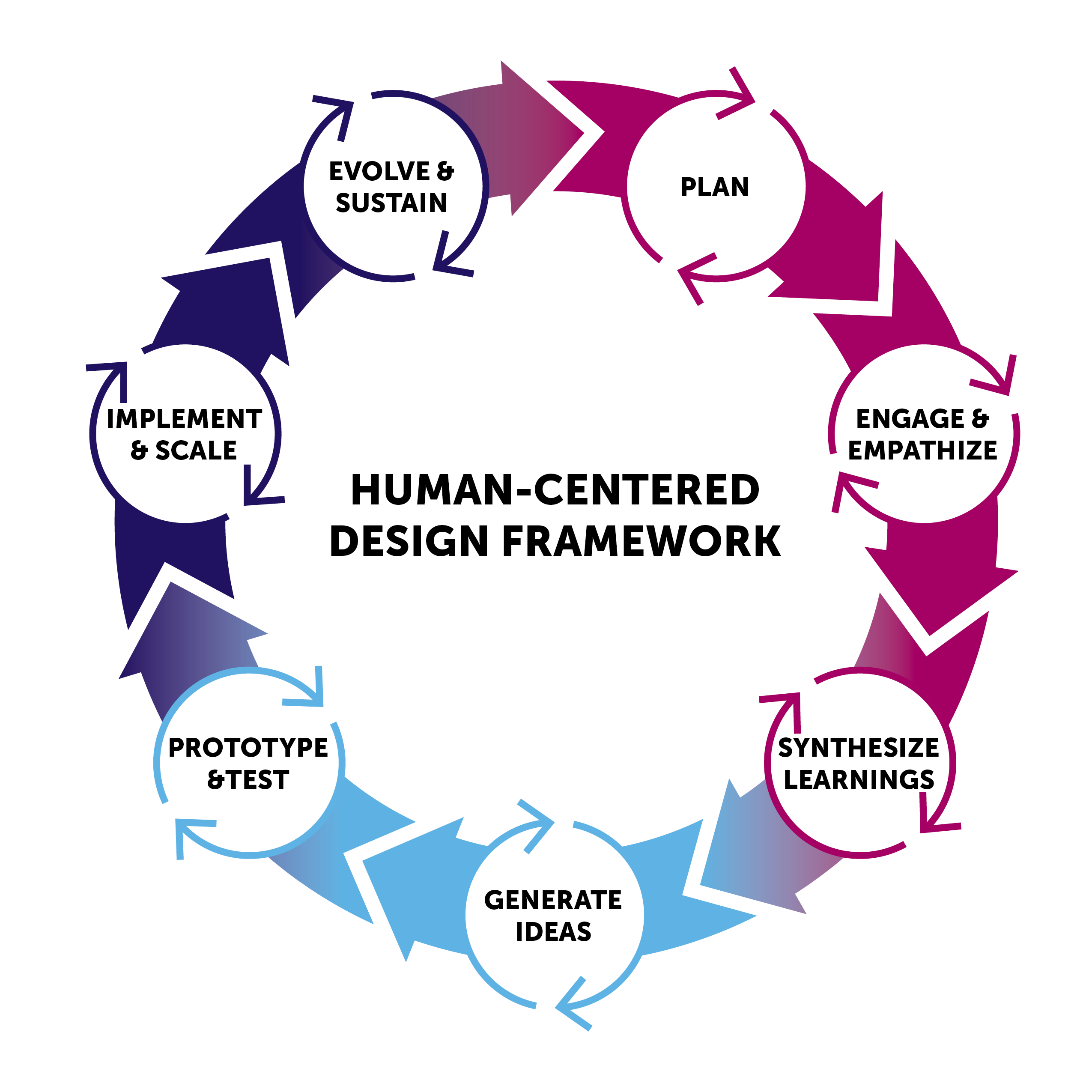Catalyzing Innovation in Reproductive and Sexual Health
Power to Decide catalyzes innovation in reproductive and sexual health by using human-centered design (HCD), also known as design thinking, to find creative solutions to challenges and pain points in the field.
HCD is a powerful framework for finding user-driven solutions that can have deep impact on target audiences and in the field. HCD enables us to gain radical empathy for end-users through observations and interviews and to synthesize those learnings into insights that inform the design of a product, program, or service. It also requires us to be flexible, confronting, and dismantling assumptions based on what we learn throughout the process.

What is Human Centered Design?
HCD has been referred to as a mindset, or a set of mindsets, that drives innovation. Broadly speaking, it is a set of tools and strategies that help design researchers develop innovative, user-driven solutions to complex problems.
HCD begins with a plan - typically driven by the identification of a challenge in the field. Design researchers also identify a design team of at least three people, who come from two or more sectors (ex. a behavioral psychologist, an OB/GYN, and a user experience designer). Next, the design team engages with end users by conducting interviews, observations, and other activities to gain radical empathy for their experiences. The design team synthesizes their learnings from those activities in order to further define the challenge and end-user needs. Then, they develop ‘How Might We…’ questions - questions that are specifically structured to inspire collaborative brainstorming, open up possibilities, and generate ideas for potential solutions. After identifying several concepts, the design team builds simple versions of each concept to prototype and test with end users, moving from lower fidelity to higher fidelity products, and pivoting as they learn new information about what may or may not work. Once the solution is finalized, the design team can implement and scale their solution. The design process is circular because teams can always use HCD tools and strategies as they evolve and sustain their product or service to ensure that new versions or even minor updates are user-centered.
Why Use Human-Centered Design in Reproductive Health?
At Power to Decide, we know that the reproductive health field benefits from using this methodology to develop solutions for challenges in this space. Too often, we've seen people develop or select a product, tool, or program without fully understanding the problem that their target audience is experiencing. When people start with an idea about the “right” product or service, they often use their interactions with end users to validate that idea, consciously or unconsciously, rather than staying open to what they might learn and making pivots as needed. HCD shifts the focus to end-users by requiring that design teams be flexible in adapting and potentially dismantling existing solutions based on what they learn in the process.
Power to Decide has over a decade of experience and expertise in HCD, both implementing HCD projects and building the capacity of others to apply HCD in their own work.
Bedsider
In 2008, we were wrestling with a challenge that we noticed in the field. We saw a gap between what young people were saying they wanted to do—use contraception to prevent pregnancies, and what they were actually doing—not using contraception effectively or correctly. We wanted to create a digital tool to address this gap that could impact our audience's knowledge, attitudes, and use of birth control. Working closely with IDEO, we started by engaging with members of our audience and a team of experts in the field. We rooted the project in a place of deep empathy and real connections with our audience. We recruited a small group of people who reflected the extremes on the spectrum of behaviors we were interested in—people who always used contraception and people who almost never did (despite not seeking a pregnancy and/or not wishing to contract or transmit an STI). We conducted interviews in peoples' homes, often lasting several hours. This approach helped us unearth behaviors, desires, and needs which are often difficult for people to articulate.
The core insight that resulted from our audience research was that most public health messaging about sex and contraception focused on the risk, while ignoring the benefits. We created and framed Bedsider as a sex-positive brand designed to be there in the heat-of-the-moment decision-making that often accompanies risky behaviors and can be a precursor to unintended pregnancy. We also found that young adults often place the social ramifications of behaviors (such as the ‘‘cool’’ factor) above health considerations. Rather than appealing to logic—the most common public health approach to educating people about unintended pregnancy prevention—Bedsider acknowledges that sex can be fun, complicated, and emotional. Instead of scaring people into the right behavior, Bedsider reframes the discussion. Rather than talking like the health department or a teacher, it takes the voice of your confident, knowledgeable best friend that you actually want to listen to. We continue to use HCD to iterate Bedsider to meet the needs of our growing audience.
Innovation Next Accelerator
In 2015, we developed Innovation Next, a unique incubator program that uses HCD to develop technology-enabled solutions to prevent teen pregnancy. Teams that participate in Innovation Next receive training and individualized coaching in HCD from experienced staff at Power to Decide. They use this training to ideate, plan, and prototype solutions while actively engaging their target audiences. To date, Innovation Next has trained over 60 innovators in HCD and supported the development of nearly 15 innovative solutions. Our innovators have developed game-changing approaches to preventing teen pregnancy that prompt behavior-change through technology adaptation and adoption. Innovators report that their participation in Innovation Next was “deeply influential and transformative” and that Innovation Next fundamentally changed how they approach their work in their organizations and with youth.
AbortionFinder
Power to Decide’s experience developing and maintaining Bedsider laid the groundwork for our newest technology innovation—AbortionFinder. Relying on the same lean, agile methodology that we apply to all technology innovations that we develop, we prioritized user research and feedback in the development of AbortionFinder. We used iterative design and development cycles to produce a minimal viable product (MVP), based on preliminary user research. Users tested the basic functionality of searching for a provider based on location and provided feedback that improved the site.
After many iterative cycles involving in-depth interviews with people in our target audience, prototyping, and usability testing, we scaled the site features and capabilities over time. For example, we added additional search categories, gave users the ability to filter search results based on relevant laws, and added an interactive map. We also made the entire site available in Spanish to broaden our reach. Each feature we add to AbortionFinder goes through rigorous testing with users before launch to ensure that we are meeting user needs as effectively and efficiently as possible.



